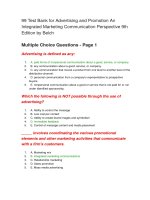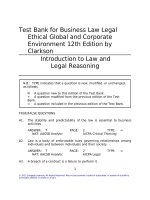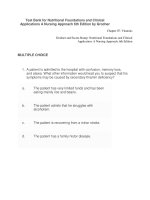Test bank for conceptual foundations the bridge to professional nursing practice 5th edition by creasia
Bạn đang xem bản rút gọn của tài liệu. Xem và tải ngay bản đầy đủ của tài liệu tại đây (53.19 KB, 9 trang )
buy this full document at
Creasia & Friberg: Conceptual Foundations: The Bridge to Professional
Nursing Practice, 5th Edition
Chapter 01: Historical Development of Professional Nursing in the United States
Test Bank
MULTIPLE CHOICE
1.
a.
b.
c.
d.
Historically, women were considered the obvious choice for nursing the sick because
caring for others was an extension of their homemaker role.
early nurses were nuns, so the public was used to females in nursing.
men, who had education, were reluctant to try nursing.
women were often at home anyway so care giving was easy.
ANS: A
Women’s domestic role (as homemakers and mothers) was naturally associated with the
caregiving required in nursing.
Although religious orders did play a role in health care, it was the domestic duties of women
that set the stage for their involvement in nursing.
Widespread education for men and women is a fairly new phenomenon and did not play a
role in the early history of nursing.
Women did not care for sick or injured strangers in their homes, so being at home was
irrelevant.
DIF:
2.
a.
b.
c.
d.
Cognitive level: Knowledge
REF: Page 3
Florence Nightingale’s views about trained nurses were most influenced by her
experiences in wartime.
ideas about sanitation.
relationships with physicians.
view of education.
ANS: A
Nightingale’s experiences in wartime demonstrated to her that trained nurses were valuable
in decreasing morbidity and mortality among soldiers.
Nightingale had revolutionary ideas about hospital sanitation, but these are not credited with
her advocacy of using trained nurses.
Early trained nurses were taught to follow the directions of the physician; collegial
relationships were not a part of health care practice in Nightingale’s day.
Nightingale’s views of education were influenced by her opinion on the value of the trained
nurse, not the other way around.
DIF:
Cognitive level: Knowledge
REF: Page 3 - 4
buy this full document at
Full file at />3.
a.
b.
c.
d.
A nursing instructor explains to her students that the major goal of the Society of
Superintendents of Training Schools for Nurses of the United States and Canada was to
improve working conditions for students.
obtain legal recognition for the profession.
raise and standardize the training of nurses.
reverse discrimination in admissions policies.
ANS: C
Students were expected to work in apprenticeship during their education in the hospitalbased programs in existence at the time.
Obtaining legal recognition for nurses was the goal of the Nurses’ Associated Alumnae of the
United States and Canada, later renamed the American Nurses Association.
Discrimination in nursing existed well into the Civil Rights era and beyond, with men and
women of color routinely being banned from admission and employment.
DIF:
4.
a.
b.
c.
d.
Cognitive level: Comprehension
REF: Page 5
Today’s nurse understands that legal recognition for nurses was imperative to
allow nurses to expand beyond the hospital setting.
lobby for better wages and working conditions.
protect the public from untrained nurses.
provide hospitals with accreditation requirements.
ANS: C
The goal of the Nurses’ Associated Alumnae of the United States and Canada (renamed the
American Nurses Association in 1912) was to protect the public from untrained nurses by
securing legal recognition for trained nurses.
Graduate nurses predominantly worked as private duty nurses up through the early 20th
century.
Wages remained low, and working conditions remained long and arduous in the hospital (and
seasonal for private duty nurses) until hospitals began hiring more graduate nurses in the
1930s.
Hospital accreditation is a recent phenomenon, unattached to legal recognition for nurses.
DIF:
5.
a.
b.
c.
d.
Cognitive level: Knowledge
REF: Page 5
Which patient would most likely have been cared for in a hospital in the 19th to early
20th century?
Dying patient
Contagious patient
Homeless patient
Woman in labor
ANS: C
Hospitals were considered places for people who had no one else to care for them.
Mosby items and derived items © 2011, 2007 by Mosby, an imprint of Elsevier Inc.
Full file at />Most patients were cared for in their homes. A dying patient probably would have been cared
for at home.
Most patients were cared for in their homes. A patient with a communicable illness would
have probably been confined to his or her home.
Most patients were cared for in their homes. Women in labor typically had their children at
home.
DIF:
6.
a.
b.
c.
d.
Cognitive level: Knowledge
REF: Page 5
Lillian Wald’s contribution to nursing can best be described as the
creation of community health nursing.
development of college-based nursing schools.
establishment of the Navy Nurse Corps.
foundation of maternal-child nursing.
ANS: A
Wald responded to the changing social conditions in the late 1800s by establishing the Henry
Street Settlement and Henry Street Visiting Nurse Services in response to the horrendous
health conditions she witnessed in New York City.
Wald was not involved in establishing college-based nursing programs.
Wald was not involved in establishing the Navy Nurse Corps.
Wald was not involved in establishing maternal-child nursing as a specialty, although she did
care for many new mothers and their infants as part of her community nursing role.
DIF:
7.
a.
b.
c.
d.
Cognitive level: Knowledge
REF: Page 7
Which event eventually led to the creation of military nursing?
American Civil War
Spanish-American War
World War I
World War II
ANS: B
During the Spanish-American War, trained nurses cared for soldiers suffering from yellow
fever. This convinced the military and Congress of the need for qualified nurses and set the
stage for the eventual creation of the Army Nurse Corps in 1901 and the Navy Nurse Corps
in 1908.
During the Civil War, both sides wanted women to care for the injured and ill soldiers, but
these women were mostly untrained volunteers from the middle and upper classes.
World War I occurred after the creation of the Army Nurse Corps and the Navy Nurse Corps.
World War II occurred after the creation of the Army Nurse Corps and the Navy Nurse
Corps.
DIF:
Cognitive level: Knowledge
REF: Page 8
Mosby items and derived items © 2011, 2007 by Mosby, an imprint of Elsevier Inc.
Full file at />8.
a.
b.
c.
d.
A faculty nurse explaining the stratification in nursing roles seen today tells students that
the most important event leading to this development was
desegregation in nursing.
limited nursing opportunities.
the Korean Conflict.
World War II.
ANS: D
The United States’ involvement in WWII dramatically increased the demand for trained
nurses. To help fill this need, the American Red Cross and the Office of Civilian Defense coestablished a program to train nurse aides. The success of the program encouraged hospitals
to utilize employees with various levels of skill.
Desegregation in nursing did come about in the same era as stratification, but it was not
instrumental in creating this differentiated practice.
Nursing opportunities were increasing throughout the 20th century.
Role stratification was already entrenched by the Korean Conflict.
DIF:
9.
a.
b.
c.
d.
Cognitive level: Comprehension
REF: Page 11
Discrimination against African American nurses began to wane during
Kennedy’s presidency.
the Civil Rights era.
the Vietnam War.
World War II.
ANS: D
WWII saw discrimination against African Americans begin to wane with the end of
segregation in the military Nurse Corps. At the end of WWII, many state nurses associations
ended their discrimination in membership as well; by 1952, all state nurses associations had
eliminated such discriminatory policies.
Kennedy’s presidency, although known for civil rights advancements, was not when
discrimination began to end.
The Civil Rights era occurred at approximately the same time as the Kennedy era.
The Vietnam War occurred at the same time as Kennedy’s presidency and Civil Rights era.
DIF:
Cognitive level: Comprehension
REF: Page 12
10. Between the years 1950 and 1967, the number of nurses and assistive personnel rose
dramatically as a result, in part, of the influence of the
a. Children’s Bureau.
b. Hill-Burton Act.
c. Nurse Training Act.
d. Social Security Act.
ANS: C
Mosby items and derived items © 2011, 2007 by Mosby, an imprint of Elsevier Inc.
Full file at />The Nurse Training Act provided funding for nursing student education through scholarships,
loans, recruitment, school construction and maintenance, and special educational projects.
Until its passage, federal funding for nursing education was modest at best.
The Children’s Bureau was created in 1912 in response to concerns about women and
children’s health.
The Hill-Burton Act provided federal funds for hospital construction and health care centers.
The Social Security Act of 1935 included financial aid for the elderly and Title V health care
benefits for children with disabilities.
DIF:
Cognitive level: Knowledge
REF: Page 14
11. Mildred Montag’s major contribution to nursing is considered to be
a. encouraging minority women and men to enter nursing.
b. establishing associate degree nursing programs.
c. fighting for improved wages and recognition for nurses.
d. paving the way for the military to use trained nurses.
ANS: B
In response to the severe nursing shortage in the post WWII years, Montag proposed a 2-year
nursing associate degree that would prepare technical nurses in community colleges.
Montag was not known for encouraging minorities and men to enter nursing.
Montag’s major accomplishment was not fighting for improved wages and recognition.
Montag was not involved in the military’s use of trained nurses.
DIF:
Cognitive level: Knowledge
REF: Page 14 - 15
12. Which nursing organizations are responsible for providing continuing education,
establishing practice standards, and offering certification examinations for their
members?
a. Councils of nurse educators
b. National specialty organizations
c. State boards of nursing
d. State nurses associations
ANS: B
National specialty organizations, such as the American Association of Critical Care Nurses,
arose in response to the developing nursing specialties; these organizations offer continuing
education, practice standards, and certification exams for their members.
Organizations that consist of nurse educators would be primarily concerned with nursing
education.
State boards of nursing are charged with the legal oversight of nursing in their respective
states.
State nurses associations are often lobbying and marketing organizations for nursing within a
specific state and act as the state arms of the American Nurses Association.
DIF:
Cognitive level: Knowledge
REF: Page 16
Mosby items and derived items © 2011, 2007 by Mosby, an imprint of Elsevier Inc.
Full file at />MULTIPLE RESPONSE
1.
a.
b.
c.
d.
e.
Benefits of the apprenticeship model of nursing education included (select all that apply)
a well-trained graduate nursing hospital staff.
opportunities for further education in nursing.
providing a skilled but inexpensive workforce.
providing working-class women employment.
reforms in the care of the sick and injured.
ANS: C, D, E
Nursing students provided the staffing for hospitals in exchange for their education.
Nursing gave working-class women employment alternatives to domestic or factory work.
The use of skilled, trained nurses decreased morbidity and mortality, and this benefit was
evident in both civilian and military health care.
Graduate nurses were typically employed as private duty nurses and did not remain working
in hospitals.
Further education for graduate nurses was rare; a post-diploma program was opened in 1899,
but the first undergraduate college nursing program was not opened until 1909.
DIF:
2.
a.
b.
c.
d.
e.
Cognitive level: Comprehension
REF: Page 4
When nursing registration laws were enacted, a “registered nurse” was defined as
someone who had (select all that apply)
attended an acceptable nursing program.
fit the definition of a professional nurse.
had not been convicted of any felonies.
passed a board evaluation examination.
studied under a standardized curriculum.
ANS: A, D
One of the two criteria for being a registered nurse was having attended an acceptable
nursing program.
The other criterion for being a registered nurse was having passed a board examination.
A weakness of the early registration laws was a lack of definition of professional nursing
practice.
Background checks were not part of the early registry laws.
Universal education standards were still lacking in 1903 when the first registry law was
passed in North Carolina.
DIF:
Cognitive level: Comprehension
REF: Page 5
3. Nurses in private duty positions faced several hardships, including (select all that apply)
a. a shortage of nurses as schools limited enrollment.
b. a surplus of nurses starting in the mid 1920s.
c. employment that was sporadic and seasonal.
Mosby items and derived items © 2011, 2007 by Mosby, an imprint of Elsevier Inc.
Full file at />d. opportunities primarily working with poorer families.
e. pay that continued to be lower than other jobs.
ANS: B, C, E
The increased enrollment in schools led to a surplus of graduate nurses.
Because communicable illnesses were often seen in the cooler months, employment for the
private duty nurse was seasonal.
According to the Geister report (1926), nurses made less money than scrubwomen and
worked in mostly short-term private duty cases.
Schools were pressured to increase enrollment as the hospital census began to rise for the
first time.
Only the middle-to-upper class could afford to hire private duty nurses.
DIF:
4.
a.
b.
c.
d.
e.
Cognitive level: Comprehension
REF: Page 6
Community health nursing has been vital in shaping America’s health system and
nursing in general by providing (select all that apply)
advocacy regarding matters of health and welfare.
autonomous nursing practice in patients’ homes.
means to check on patients’ compliance with treatment.
novel activities in health promotion and disease prevention.
treatment that didn’t rely on the patient’s ability to pay.
ANS: A, D
Community health nurses expanded nursing services to new areas, including school,
industrial, tuberculosis, and infant welfare nursing. They combined their training and
knowledge to educate the public and served as the backbone for the Maternal and Infant Act
of 1921.
Community health nurses combined their training and knowledge to bring education to the
public in order to promote health and well-being.
Private duty nurses had always been the mainstay of nursing work; these nurses worked
semi-autonomously in patients’ homes.
A system for determining compliance was not a part of the developing health care system in
this country.
The use of community health nursing increased because of concern with the public’s health,
not the patient’s ability to pay.
DIF:
5.
a.
b.
c.
d.
e.
Cognitive level: Comprehension
REF: Page 7
Social events surrounding the Great Depression that had a major impact on American’s
emerging health care system included (select all that apply)
Blue Cross was developed as a prepaid health insurance plan.
large hospitals experienced increasing numbers of nonpaying patients.
many hospitals found their nursing schools too expensive to operate.
nurses were hired in hospitals in increasing numbers.
religious orders began supplying trained nurses, cutting the cost of nursing.
Mosby items and derived items © 2011, 2007 by Mosby, an imprint of Elsevier Inc.
Full file at />ANS: A, B, C, D
The development of Blue Cross helped hospitals’ financial stability by providing patients
who were able to pay for care.
Large hospitals, particularly those in cities, experienced more patients who needed medical
care but were unable to afford it because of the economic hardships of the Depression.
570 training programs for nurses were closed because of prohibitive costs during the decade
of the Depression.
As hospital care became more sophisticated, more nurses were hired as staff. By 1941, over
100,000 registered nurses were employed in hospitals.
Religious orders did not provide trained nurses to hospitals in order to decrease the cost of
the nursing staff.
DIF:
6.
a.
b.
c.
d.
e.
Cognitive level: Comprehension
REF: Page 10
The development of associate degree (AD) nursing programs has had which effect on
nursing today? (Select all that apply.)
A wider student pool has been able to study nursing.
AD programs have helped ease the nursing shortage.
Hospitals have been influenced to close their training programs.
Improved social status for graduates of nursing programs.
The public has suffered some confusion about nursing education.
ANS: A, B, C, E
Nontraditional students, such as mothers and older students, have found it convenient to
study nursing at community colleges.
More nurses enter the profession via AD programs than through baccalaureate and diploma
programs combined.
As college education for nurses became more widespread and accepted, hospital directors
became convinced to close their expensive programs, lessening the burden of hiring a
professional nursing staff.
The public and indeed, nursing, does suffer from confusion about the educational
requirements for becoming a registered nurse.
AD programs do not necessarily contribute to the improved social status of nurses.
DIF:
7.
a.
b.
c.
d.
Cognitive level: Comprehension
REF: Page 15
Enrollment in college-based nursing programs was initially hindered by (select all that
apply)
a lack of qualified applicants.
little social and financial support.
poorly trained faculty members.
restrictive admissions criteria.
ANS: A, B
Mosby items and derived items © 2011, 2007 by Mosby, an imprint of Elsevier Inc.
Full file at />Nursing education differed from medical education, which had seen a rise in stature as a
result of social support and financial endowments.
Aspiring nurses found the time and monetary commitment to be too great compared with
diploma programs.
Poorly trained faculty members were not a factor in limited enrollment into college
programs.
Restrictive admissions criteria were not a factor in limited enrollment into college programs.
DIF:
Cognitive level: Knowledge
REF: Page 11
Mosby items and derived items © 2011, 2007 by Mosby, an imprint of Elsevier Inc.









